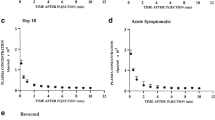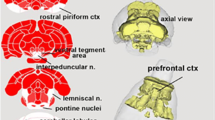Summary
Whether the increased capillary permeability characteristic of diabetes extends to the blood-brain barrier is presently unclear. We have examined in streptozotocin-diabetic rats the permeability of the blood-brain barrier at the level of 12 discrete brain regions employing 3 intravenous tracers of different molecular weight: sucrose, inulin and horseradish peroxidase. In animals killed 5 min after tracer injection both the sucrose and the inulin spaces were similar to controls. In order to assess whether more prolonged circulation of tracers would uncover leakage, we studied brain spaces at longer intervals after tracer injections. When inulin was allowed to circulate for 15 min prior to killing, animals with 4 weeks of diabetes (but not 2 weeks) exhibited larger inulin spaces at the level of the medio-basal hypothalamus (p<0.01), medio-dorsal hypothalamus (p<0.05) and periaqueductal gray (p< 0.01). Horseradish peroxidase, even after 75 min of perfusion, remained confined in both diabetic and control animals to central nervous system areas devoid of blood-brain barrier. Thus, after a relatively short duration of diabetes the blood-brain barrier manifests an increased permeability. It is subtle, limited to some brain regions and selective for low molecular weight tracers.
Article PDF
Similar content being viewed by others
Avoid common mistakes on your manuscript.
References
Parving H-H (1976) Increased microvascular permeability to plasma proteins in short- and long-term juvenile diabetics. Diabetes 25 (Suppl 2): 884–889
Palmberg PF (1977) Diabetic retinopathy. Diabetes 26: 703–711
Mogensen CE, Christensen CK, Vittinghus E (1983) The stages in diabetic renal disease with emphasis on the stage of incipient diabetic nephropathy. Diabetes 32 (Suppl 2): 64–78
Cunha-Vaz JG, Gray JR, Zeimer RC, Mota MC, Ishimoto BM, Leite E (1985) Characterization of the early stages of diabetic retinopathy by vitreous fluorophotometry. Diabetes 34: 53–59
Dorchy H, Toussaint C, Devroede M, Ernould C, Loeb H (1977) Diagnostic de la retinopathie diabetique infantile par angiographie fluoresceinique. Nouv Presse Med 6: 345–347
Tso MOM, Cunha-Vaz JG, Shih C-Y, Jones CW (1980) Clinicopathologic study of blood-retinal barrier in experimental diabetes mellitus. Arch Ophthalmol 98: 2032–2040
Wallow IHL, Engerman RL (1977) Permeability and patency of retinal blood vessels in experimental diabetes. Invest Ophthalmol Vis Sci 16:447–461
Lorenzi M, Karam JH, Mcllroy MB, Forsham PH (1980) Increased growth hormone response to dopamine infusion in insulin-dependent diabetic subjects: indication of possible bloodbrain barrier abnormality. J Clin Invest 65: 146–153
Jakobsen J, Malmgren L, Olsson Y (1978) Permeability of the blood-nerve barrier in the streptozotocin-diabetic rat. Exp Neurol 60: 277–285
Stauber WT, Ong S-H, McCuskey RS (1981) Selective extravascular escape of albumin into the cerebral cortex of the diabetic rat. Diabetes 30: 500–503
Morrison AB (1959) The distribution of intravenously-injected inulin in the fluids of the nervous system of the dog and rat. J Clin Invest 38: 1769–1777
Reed DJ, Woodbury DM (1963) Kinetics of movement of iodide, sucrose, inulin and radio-iodinated serum albumin in the central nervous system and cerebro-spinal fluid of the rat. J Physiol 169: 816–850
Reese TS, Karnovsky MJ (1967) Fine structural localization of a blood-brain barrier to exogenous peroxidase. J Cell Biol 34: 207–217
Harms PG, Ojeda SR (1974) A rapid and simple procedure for chronic cannulation of the rat jugular vein. J Appl Physiol 36: 391–392
Mesulam M-M (1978) Tetramethyl benzidine for horseradish peroxidase neurohistochemistry: a non-carcinogenic blue reaction product with superior sensitivity for visualizing neural afferents and efferents. J Histochem Cytochem 26: 106–117
Ferguson RK, Woodbury DM (1969) Penetration of14C-inulin and14C-sucrose into brain, cerebrospinal fluid, and skeletal muscle of developing rats. Exp Brain Res 7: 181–194
Thompson AM (1970) Hyperosmotic effects on brain uptake of non-electrolytes. In: Crone C, Lassen NA (eds) Capillary Permeability. Pedersens V Bogtrykkeri A/S, Copenhagen, p 459–467
Barranger JA, Rapaport SI, Fredericks WR, Pentchev PG, MacDermot KD, Steusing JK, Brady RO (1979) Modification of the blood-brain barrier: increased concentration and fate of enzymes entering the brain. Proc Natl Acad Sci USA 76: 481–485
Cooper PH, Novin D, Butcher LL (1982) Intracerebral 6-hydroxydopamine produces extensive damage to the blood-brain barrier in rats. Neurosci Lett 30: 13–18
Heistad DD, Marcus ML (1979) Effect of sympathetic stimulation on permeability of the blood-brain barrier to albumin during acute hypertension in cats. Circ Res 45: 331–338
De La Torre JC (1971) The blood-brain barrier for L-Dopa in the hypothalamus. J Neurol Sci 12: 77–93
Gregory TJ, Wallis CJ, Printz MP (1982) Regional changes in rat brain angiotensinogen following bilateral nephrectomy. Hypertension 4: 827–838
Rapaport SI (1976) Blood-brain barrier in physiology and medicine. Raven, New York, p 76–78
Kirber WM, Nichols CW, Grimes PA, Winegrad AI, Laties AM (1980) A permeability defect of the retinal pigment epithelium: occurrence in early streptozotocin diabetes. Arch Ophthalmol 98: 725–728
Swanson LW, Kucharczyk J, Mogenson GJ (1978) Autoradiographic evidence for pathways from the medial preoptic area to the midbrain involved in the drinking response to angiotensin II. J Comp Neurol 178: 645–660
Smith QR, Johansen CE, Woodbury DM (1981) Uptake of36CI and22Na by the brain-cerebrospinal fluid system: comparison of the permeability of the blood-brain and blood-cerebrospinal fluid barriers. J Neurochem 37: 117–124
Maccario M (1968) Neurological dysfunction associated with nonketotic hyperglycemia. Arch Neurol 19: 525–534
Johansen K, Hansen AP (1971) Diurnal serum growth hormone levels in poorly and well-controlled juvenile diabetics. Diabetes 20:239–245
Hansen AP (1970) Abnormal serum growth hormone response to exercise in juvenile diabetics. J Clin Invest 49: 1467–1478
Guthrow CE, Morris MA, Day JF, Thorpe SR, Baynes JW (1979) Enhanced nonenzymatic glucosylation of human serum albumin in diabetes mellitus. Proc Natl Acad Sci USA 76: 4258–4261
Williams SK, Devenny JJ, Bitensky MW (1981) Micropinocytic ingestion of glycosylated albumin by isolated microvessels: possible role in pathogenesis of diabetic microangiopathy. Proc Natl Acad Sci USA 78: 2393–2397
Author information
Authors and Affiliations
Rights and permissions
About this article
Cite this article
Lorenzi, M., Healy, D.P., Hawkins, R. et al. Studies on the permeability of the blood-brain barrier in experimental diabetes. Diabetologia 29, 58–62 (1986). https://doi.org/10.1007/BF02427282
Received:
Revised:
Issue Date:
DOI: https://doi.org/10.1007/BF02427282




